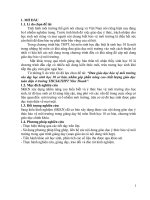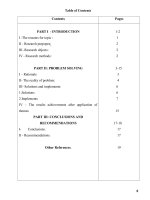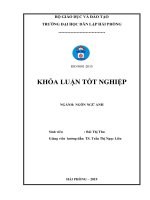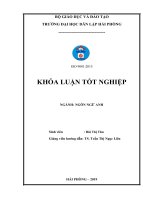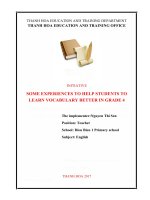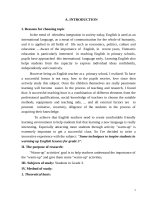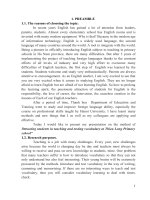Some methods to help students in grade 8 at cao ngoc secondary school pronounce correctly in english communication
Bạn đang xem bản rút gọn của tài liệu. Xem và tải ngay bản đầy đủ của tài liệu tại đây (160.43 KB, 15 trang )
1. GENERAL DISCUSSIONS
1.1: Reason for choosing the topic.
As we know, English has become popular worldwide and more than forty
countries are using English as a primary language, and nearly 400 million people
are using it as a second language in communication. In Vietnam, English is seen as
a key that leads to the success today.
As a teacher of English department, we always want our students to
understand fast and efectively, especially the children can apply the knowledge in
actual communication. For this, we need to have innovative teaching methods so
that each class students are more interested in active learning and memory training
class at all.
We all know that any languages in the world which we use to communicate
with requires us a large vocabulary because vocabulary is an integral part of the
language. In studying English we can not train and develop the four skills:
listening, speaking, reading and writing that are not based on the correct
pronounciation of the vocabulary and sentences.
Therefore, to help students master the correct pronounciation in English
communication, I decided to implement the project:
"Some methods to help students in grade 8 at Cao Ngoc secondary school
pronounce correctly in English communication"
1.2: Purpose of the study:
A lot of students think that English is a difficult subject. Learning English
requires time, perseverance and the level of application of learners in practice;
requires learners to have the right attitude, clearly define the purpose of the study to
try to reach the intended goal. In addition, students must be passion, always want to
explore, take advantage of every opportunity to learn and practice regullarly. I
notice that there are many difficulties in learning and practising English; Students
are not incapable of acquiring new knowledge, but they do not have an effective
method of learning English ..
The purpose of learning a foreign language is to communicate that the
majority of students pronounce in the wrong communication process due to the
influence of their native language, ethnic minority language. During the teaching
process, I learned some experiences to overcome this weakness. These experiences
have been shown in the topic: "Some methods to help students in grade 8 at Cao
Ngoc secondary school pronounce correctly in English communication"
1.3: Research objects
All students who are studying English at Cao Ngoc secondary school have
been applied by me and they have achieved good results. However, in this topic, I
would like to practice only the 59 grade 8 students at Cao Ngoc secondary school
so that the comrades can see remarkable progress in students.
1.4: Research methods.
- Researching documents.
- Read references.
- Research through English software: />1
- Actual survey.
- Understanding the learning situation of students.
2. CONTENT
2.1. Rationale
In teaching and learning English, it is important and necessary to speak correctly
and pronounce words correctly as well as intonate exactly. The correct
pronunciation helps students:
- Confident to communicate
- Help other people easily understand what they want to express.
- Do good phonics exercises in the tests.
As a teacher who directly teaches English at junior high school, I realize the need
to help students step by step improve pronunciation and sound practice.
2.2. Situation before applying experience initiatives.
Through the process of directly teaching grade 8, through the results on the
learning results of students recent school years, I find that the rate of weak students
of grade 8 is often very high. The ability to speak English is very poor, they read
95% of single words wrongly and 95% wrong pronunciation exercises. Wondering
about such situation, at the beginning of the school year 2018 - 2019, I conducted
experiment with 59 grade 8 students on the following two contents. And I obtained
the following results:
Survey content
English speaking
ability
Excellent
0
student
%
Good
%
average
%
bad
0
0
students
0
15
25
44
students
students
%
75
The results of the quality survey at the beginning of the year with 59 students
show that the number of students who cannot speak English and do phonetic
exercises is too high: 75% of students have bad ability, 25% of students students
have average ability, and especially the number of students with good and good
abilities is zero.
2.3. Solutions and measures:
"Some methods to help students pronounce correctly in English communication
and do phonics exercises correctly"
First of all, the teacher must be the correct and accurate English speaker for
students to follow. To do this, teachers must always learn and improve their
knowledge.
In the process of teaching, revision lessons as well as tutoring weak students
or fostering good students, we must integrate the following contents:
In addition to teaching the English alphabet to students we need to teach
them how to read and use the IPA alphabet for the following reasons:
The international phonetic alphabet is used in learning a new language for
pronunciation and hearing ability. It is also used in voice training for students to
have an inspiring voice or change the tone of the language. IPA can help us to use
2
mouth, lips, teeth, tongue position and how to control airflow to produce standard
sound when learning a foreign language.
The IPA table contains 44 sounds, the upper part is vowel and the lower part
is consonant.
The vowel consists of 20 sounds that are divided into 2 halves, on the right
is a double vowel and on the left is a single vowel. Single vowels will be arranged
in pairs, with the opening of the mouth growing from top to bottom. Consonants
are also arranged in pairs of fuzzy sounds that are consonant without vibrating and
bold tones that are vibrating consonants.
IPA alphabet will help students practice standard phonics right from the
starting point. Learning to pronounce each syllable correctly, students will
pronounce each word correctly and then to a higher level than phrases and
sentences. Students will not encounter the situation that they say they understand.
Besides, the IPA table will help students understand the pronunciation of a new
word by looking it up in the dictionary and combining the sounds again to
pronounce the words correctly.
We should teach students to start with each sound. When learning a sound,
study it carefully. Teach students to understand the rules of pronunciation in a
detailed and scientific way, such as how to position the parts to make sounds, how
to flow a bit, how to form a mouth? ... Help them to be confident daily practice this
section.When teaching the sounds we have to pay attention to comparing the same
sounds, the sounds or the mistakes, helping students learn it carefully to distinguish
them.
The next step, without stopping at a single tone, we need to practice giving
them that sound in words with different positions such as head, middle and end
3
words; practice in sentences, in paragraphs. More specifically, to make learning
phonics enjoyable, not boring, we should let them practice with their friends in the
form of competitions; Search for real, interesting, funny materials such as videos,
stories... in which we can help students pronounce and intonate in sentences in the
most natural and accurate way.
How to pronounce some letters:
HOW TO READ THE LETTER "a"
- "a" is often read as / æ / in words that have 1 syllable but end with 1 or more
consonants
e.g. bag / bæg /, ban / ban /, cab / kæb /, bank / bæŋk /
or: in syllables, the accent of the syllable word is pressed and the two consonants
are in front.
e.g. candle / ˈkændl /, manner / ˈmænə (r) /
- "a" is read as / ɔː / in a syllable word and when "a" is "l" or "a" precedes /
followed by "w".
e.g. call / kɔːl /, fall / fɔːl /, war / wɔːr /, awful / ˈɔːfəl /
- "a" is pronounced as / e /
e.g. many / 'meni /, anyone / ˈeniwʌn /
- "a" is also pronounced as / ɑː / in some cases.
e.g. father / ˈfɑːðə (r) /, bar / bɑː (r) /, start / stɑːt /
- "a" is read as / / ɪ / in the "age" noun except garage / /gærɑːʒ /, massage /
ˈmæsɑːʒ /
e.g. storage / ˈstɔːrɪdʒ /, shortage / ˈʃɔːtɪdʒ /, cottage / ˈkɒtɪdʒ /
- "a" is read as / eɪ / in the syllable before "-ion, -ian"
e.g. nation / ˈneɪʃən /, reputation / ˌrepjʊˈteɪʃən /, Asian / ˈeɪʒn /
- "a + consonant + e" is read / eɪ / (except "a + r + e" read / eə /)
e.g: earthquake / ˈɜːθkweɪk /, tape / teɪp /, care / keər /
- "a" → / eə / when "ai + r"
e.g. chair / tʃeər /, hair / heər /, fair / feər /
- "a" → / eɪ / when "ai + other consonants"
e.g. contain / kənˈteɪn /, sail / seɪl /
- "ai" → / ɪ / or / ə / in syllables without accents
e.g. bargain / ˈbɑːgɪn /, mountain / ˈmaʊntən /
- "au" is read as / ɑː / in aunt / ɑːnt /, laugh / lɑːf /, draft / drɑːft / and read as / ɔː /
in the remaining words
e.g. audience / ˈɔːdiəns /, mausoleum / ˌmɔːsəˈliːəm /
- "ar":
+ is read as / ɑː /
e.g. car / kɑː (r) /, dark / dɑːk /
+ is read as / eə / when located in are cluster or in some cases.
e.g. care / keə (r) /, vegetarian / ˌvedʒəˈteəriən /
- "ay" → / eɪ / when "ay" is at the end of the word.
e.g. clay / kleɪ /, play / pleɪ /
HOW TO READ THE LETTER "b"
4
- "b" is pronounced as / b /
e.g. brother / ˈbrʌðə (r) /, bake / beɪk /
- "b" is mute (not read) when behind "m" or "t"
e.g. comb / kəʊm /, tomb / tuːm /, debt / det /, doubt / daʊt /
HOW TO READ THE LETTER "c"
- "c" is read as / s / when preceding "e, i, y"
e.g. cell / sel /, city / ˈsɪti /, cycle / ˈsaɪkl /
- "c" is read as / k / when it follows "s" or when it precedes "a, o, u and l, r"
e.g. scale / skeɪl /, call / kɔːl /, cost / kɒst /, curtain / ˈkɜːtn /, claim / kleɪm /
"c" is read as / ʃ / when it precedes "ia, ie, io, ea"
e.g. sufficient / səˈfɪʃənt /, suspicious / səˈspɪʃəs /, ocean / ˈəʊʃn /
"c" is read as / tʃ /
e.g. cello / ˈtʃeləʊ /, concerto / kənˈtʃɜːtəʊ /
"c" dumb in some cases after "s"
e.g. scene / siːn /, science / ˈsaɪəns /, scissors / ˈsɪzəz /
"ch" is read as / k / or / ʃ / or / tʃ /
e.g. school / skuːl /, machine / m ,iːn /, cheap / install /
HOW TO READ THE LETTER "e"
"ee" is prounonced / i: / and "eer" is read as / ɪə (r) /.
e.g. deep / diːp /, volunteer / ˌvɒlənˈtɪər /
"er" is often read as / ɜː / or / ə / depending on the stress of the word.
e.g. infer / ɪnˈfɜːr /, prefer / prɪˈfɜːr /, suffer / ˈsʌfər /, enter / ˈentər /
"ex" is prounonced:
+ / eks / when there is an accent.
e.g. exercise / ˈeksəsaɪz /, excellent / ˈeksələnt /
+ / iks / when there is no accent and before a consonant.
e.g. extend / ɪkˈstend /
+ / igz / when there is no accent and precede the vowel.
e.g. exact / ɪgˈzækt /, example / ɪgˈzɑːmpl /
HOW TO READ THE LETTER "g"
- "g" → / g / when standing before "a / o / u" and consonants and in some cases
with "i"
e.g. good / gʊd /, gallery / ˈgæləri /, grow / grəʊ /, guard / gɑːd /, girl / ɡɜːl /
"g" → / dʒ / when standing before "e / i / y" or in a word with the end "ge".
e.g. genetic / dʒəˈnetɪk /, gym / d /m /, ginger / ˈdʒɪndʒər /, cage / keɪdʒ /
Exception: massage / ˈməsɑːʒ /, mirage / ˈmərɑːʒ /
HOW TO READ THE LETTER "h"
"h" is pronounced as / h /.
e.g. hen / hen /, height / haɪt /
"h" dumb when it is behind "r" or "ex".
e.g. rhythm / ˈrɪðəm /, rhyme / raɪm /, exhaust / ɪgˈzɔːst /, exhibit / ɪgˈzɪbɪt /
"h" mute in the following cases:
e.g. heir / eər /, hour / aʊər /, honour / ˈɒnər /, honorable / ˈɒnərəbl /, honest /
ˈɒnɪst /, honesty / ˈɒnəsti /
5
HOW TO READ THE LETTER "i"
"i + consonant + e" → / aɪ /
e.g. mine / maɪn /, decide / dɪˈsaɪd /
"ie"
+ is read as / i: / when "ie" stands in the middle of the word.
e.g. believe / bɪˈliːv /, chief / tʃiːf /
+ is read as / ai / when "ie" is at the end of or before "t".
e.g. die / daɪ /, diet / ˈdaɪət /
"ir" is read / ɜː /
e.g. bird / bɜːd /, girl / gɜːl /
HOW TO READ THE LETTER "k"
"k" is pronounced as / k /.
e.g. skill / skɪl /, kitchen / ˈkɪtʃɪn /
"k" mute when leading from and before "n".
e.g. knee / niː /, knife / naɪf /, knock / nɒk /, knob / nɒb /
HOW TO READ THE LETTER "o"
- "o" is pronounced as / ʌ / in 1-syllable words or in syllables emphasized by
syllable words.
e.g. love / lʌv /, company / ˈkʌmpəni /
- "o" is pronounced as / ɒ / in some cases.
e.g. doctor / ˈdɑːktə (r) /, bottle / ˈbɑːtl /
- "o" is pronounced as / ʊ / in some cases.
e.g. woman / ˈwʊmən /, wolf / wʊlf /
- "o" → / uː / in 1 some common words ending in "o" or "o + consonants".
e.g. do / duː / (strong form), remove / rɪˈmuːv /
- "o" → / əʊ / when it is at the end of 1 word or in some other case.
e.g. previous / ə'gəʊ /, mosquito / məˈskiːtəʊ /, tomato / təˈmeɪtəʊ /, control / kən
ˈtrəʊl /
- "o" → / ɜː / when it follows "w".
e.g. work / wɜːk /, worst / wɜːst /
- "o" → / ə /
e.g. boredom / ˈbɔːdəm /, control / kənˈtrəʊl /
"oa" → / ɔː / when there is "r" behind, the remaining "oa" reads / əʊ /.
e.g. coat / boat /, boat / bəʊt /, roar / rɔːr /, board / bɔːd /
"oo" → / ʌ / in blood / blʌd /, flood / flʌd /
"oo" → / ʊə / in words with 1 syllable ending in "r"
"oo" → / ʊ / or / uː / in most of the remaining words.
e.g. poor / pʊə (r) /, wool / wʊl /, doomsday / ˈduːmzdeɪ /
"or" → / ɔː / when an accent is received or / ə / when no accent is received.
e.g. important / ɪmˈpɔːtənt /, sword / sɔːd /, labor /ˈleɪbə (r) /
"ou" → / ʌ / in the "ou + consonant" group
e.g. rough / rʌf /, cousin / ˈkʌzn /
- "ou" → / ʊ /
e.g. could / kʊd /, would / wʊd /
6
- "ou" → / uː /
e.g. group / ɡruːp /, wound / wuːnd /
- "ou" → / ə / in the phrase "ous"
e.g. famous / ˈfeɪməs /, prosperous / ˈprɒspərəs /
- "ou" → / aʊ / in words has "ou + consonant" groups.
e.g. about / əˈbaʊt /, south / saʊθ /
- "ou" → / əʊ /
e.g. soul / səʊl /, poultry / ˈpəʊltri /
- "ou" → / ʊə /
e.g. tour / tʊə (r) /
"ow" → / aʊ /
e.g. power / ˈpaʊə (r) /, drown / drafts /
- "ow" → / əʊ /
e.g. blow / bləʊ /, arrow / ˈærəʊ /
HOW TO READ THE LETTER "u"
"u" → / ɜː / in the group "ur + consonants" when this group receives accents
e.g. urge / ɜːdʒ /, surgery / ˈsɜːdʒəri /
"u" → / ə /
e.g. suggest / səˈdʒest /, surprise / səˈpraɪz /
"u" → / ʌ / in the ending words "u + consonants".
e.g. cup / cup /, skull / skʌl /
"u" → / uː /
e.g. salute / səˈluːt /, lunar / ˈluːnə (r) /
"u" → / jʊ / or / juː /
e.g. cure / kjʊə (r) /, commune / ˈkɒmjuːn /
"ui" → / aɪ / in words with "ui + consonants + e"
e.g. guide / gaɪd /, quite / kwaɪt /
"ui" → / ɪ /
e.g. quit / kwɪt /, guilty / ˈɡɪlti /
"ui" → / juː / in "suit"
e.g. suitable / ˈsjuːtəbl /, pursuit / pəˈsjuːt /
"ui" → / uː /
e.g. fruit / fruːt /, cruise / kruːz /
"uy" → / aɪ /
e.g. guy / ɪaɪ /, buy / baɪ /
HOW TO READ THE LETTER "y"
"y" → / j / when leading a word.
e.g. yell / jel /, yesterday / ˈjestədeɪ /
"y" → / aɪ / in a syllable word or in syllables the accent of 2 syllables.
e.g. cry / kraɪ /, deny / dɪˈnaɪ /
"y" → / i / when nouns (n), adjective (adj), adverb (adv) or non-accent syllables.
e.g. slippery / ˈslɪpəri /, muddy / ˈmʌdi /
SUMMARY
7
The above is a reading of some IPA alphabetical letters to note, and I have
summarized it with a summary, but there are some exceptions:
Vowels
Single vowel
Corresponding letters
/ iː /
i, e, ee, ea, ie, ei (after the characters "c" and "s")
/ ɪ / or / i /
i, y, e (in the syllable not emphasized), u, a + consonant + e
/e/
e, ea
/æ/
A
/ ɑː /
a, ar
/ʌ/
o, ou, o + consonants + e, u
/ ɔː /
a, all, alt, au, aw, or, our, oar, oor
/ɒ/
o, ock, bee
/ uː /
u, o, oo, ew, ue, ui
/ʊ/
o, oo, ould, u
/ ɜː /
er, ear, ir, or (after w), ur
/ə/
most vowels are not emphasized
Double
Corresponding letters
vowels
/ eɪ /
a, ai, ay, ey, a + consonant + e, eigh, eign
/ aɪ /
ie, ye, y (in 1 syllable / syllable word is pressed), i + consonant
+ e, ui + consonant + e, y + consonant + e, igh, ild, ind
/ ɔɪ /
oi, oy
/ əʊ /
o, oa, old, ow, o + consonants + e
/ aʊ /
ow, ou
/ eə /
air, are, ear, eir
/ ɪə /
ear, eer, ere, ier
/ ʊə /
oor, our, ur
Consonant
The corresponding letter
/p/
P
/b/
B
/t/
T
/d/
D
/k/
k, c, que, ch (Greek words)
/g/
g, gh
/m/
M
/n/
N
/ŋ/
n (before "k"), ng
/f/
f, ph, gh (at the end of the word)
/v/
V
8
/θ/
Th
/ð/
/s/
/h/
/ tʃ /
Th
s, ss, se, c (before "e, i" and "y"), x (in the phrase "ex" before
consonants), in the phrase "sive"
z, zz, s (between two vowel characters), x (in the phrase "ex"
before the vowel), in the phrase "ism, izm"
s (after the previous consonant "u, ia, io"), ss, c, sh, cluster "cian
/ tion", phrase "sion / sure" (these clusters are after consonants),
"tial / cial / tious / cious ”
phrase "sion / sure" (clusters after vowels), ge (words with
French roots)
H
ch, phrase "tion" (when standing behind "s"), the phrase "ture"
/ dʒ /
g, ge, j
/r/
r, rr
/z/
/ʃ/
/ʒ/
/l/
/j/
/w/
l, ll
y, u, in the phrase "ew / ue"
w, wr
Mute consonant
In English there are some unreadable consonants in some words that contain
corresponding handwriting symbols. It is called a silent consonant.
For example. / h / in the word "hour" can not be read: hour / ˈaʊə (r) /
I consider the following popular silent consonants:
symbols
characteristics
examples
b
after "m"
climbing / klaɪm /, comb / kəʊm /
t
in the sten cluster
listen /ˈlɪsn/
in stle cluster
whistle /ˈwɪsl/
in the phrase ften
often /ˈɒfn/
Christmas /ˈkrɪsməs/
k
before "n" at the
knob /nɒb/ , knee /niː/ , know /nəʊ/ , knife
beginning of the knob / /naɪf/
nɒb /, knee / niː /,
know / nəʊ / knife /
naɪf /
g
before "n" at the
gnaw /nɔː/ , sign /saɪn/
beginning or end from
gnaw / nɔː /, sign / saɪn /
h
start some words or
honest / ˈɒnɪst /
follow "w" in some
hour ..
words
n
after "m" at the end of
autumn
9
l
p
s
w
fall
before "k" in some
words
before "s" or "n" at the
beginning
when standing before "l"
in some words
before "r" at the
beginning
talk / tɔːk /, walk / wɔːk /, chalk / tʃɔːk /
pneumatic / njuːˈmætɪk /,
psychology / saɪˈkɒlədʒi /
island /ˈaɪlənd/
write /raɪt/ , written /ˈrɪtn/ , wrote /rəʊt/ ,
wrist /rɪst/ , wrestle /ˈresl/
d
handsome /ˈhænsəm/
Teach students to master the pronunciation of "s / es" and "ed"
How to pronounce tail "s"
/s/
/ɪz/
/z/
“s” behind the sounds “s” behind the sounds
/s/,
after the remaining sounds
/p/, /t/, /k/, /f/
/z/, /ʃ/, /tʃ/, /dʒ/
misses /ˈmɪsɪz/
cleans /kliːnz/
stops /stɑːps/
rises /ˈraɪzɪz/
plays /pleɪz/
spots /spɑːts/
washes /ˈwɒʃɪz/
clears /klɪəz/
looks /lʊks/
watches /ˈwɒtʃɪz/
rides /raɪdz/
laughs /lɑːfs/
judges /ˈdʒʌdʒɪz/
comes /kʌmz/
How to pronounce tail "ed"
/t/
/ɪd/
/d/
“ed” behind soundless
“ed” behind the voiced sounds
“ed” behind the sound
sounds like
like /b/, /g/, /v/, /z/, /ʒ/, /dʒ/, /ð/,
/t/ or /d/
/p/, /k/, /f/, /s/, /tʃ/ , /ʃ/
/m/, /n/, /ŋ/, /l/, /r/ and vowels
helped /helpt/
wanted /ˈwɒntɪd/
robbed /rɒbd/
laughed /lɑːft/
invented /ɪnˈventɪd/
hugged /hʌɡd/
missed /mɪst/
visited /ˈvɪzɪtɪd/
saved /seɪvd/
looked /lʊkt/
needed /ˈniːdɪd/
arranged /əˈreɪndʒd/
watched /wɒtʃt/
decided /dɪˈsaɪdɪd/
rained /reɪnd/
washed /wɒʃt/
provided /prəˈvaɪdɪd/
stayed /steɪd/
Teach students to master some accent rules
Rule 1: Most verbs have 2 syllables, the stress falls into the second syllable:
Eg: be’gin, for’get, en’joy, dis’cover, re’lax ...
Exceptions: ‘answer,‘ enter, ‘happen,‘ open, ‘offer
Rule 2: The majority of nouns, adjectives, adverbs include 2 syllables, the accent
falls on the first syllable.
Eg: ‘children,‘ hobby, ‘habbit,‘ lucky, ‘pretty ...
Exception: ad’vice, ma’chine, mis noake, a’lone, a’mazed ..
Rule 3: The compound verb, the accent falls into the second syllable:
Eg: be’come, under’stand ...
10
Rule 4: The accent falls on the following rhyme: sist, cur, vert, test, tain, tract, vent,
Eg: e’vent, sub’tract, prototypes of Unest, in’sist, main’tain, him’self
Rule 5: For words with the following suffix, the accent falls into the syllable itself:
- ee, -eer, -ese, -ique, -esque, -ain.
Eg: ag’ree, volun’teer, Vietna’mese ....
Exception: com’mittee, ‘coffee, em’ployee
Rule 6: Suffixes: -ic, -ish, -ical, -sion, -tion, -ance, -ence, -idle, -ious, -a, -ience, -id,
-eous, -acy, -ian, -ity, the accent falls on the syllable before it.
Rule 7: Most prefixes do not accept accents.
Eg: dis’cover, re’ly, des Nonroy, re'write ...
Exception: ‘underpass,‘ underlay ..
Rule 8: Compound nouns and compound words, the accents fall into the most
syllable
Eg: ‘birthday,‘ airport. ‘Bookshop,‘ homesick, ‘carsick ...
Exception: duty-‘free, snow’white ..
Rule 9: Compound adjectives with the first element are adjectives or adverbs, the
second part is the ending -ed, the accent falls into the second part.
Eg: bad-‘tempered, short-‘sighted, ill-‘treated ...
Rule 10: When adding suffixes: -ment, -ship, -ness, -er / or, -hood, -ing, -en, -ful,
- able, -ous, -less, the main stress of the word does not change
Eg: ag’ree __ ag’reement; ‘Meaning __‘ meaningless ...
Rule 11: The words with the ending : -graphy, -ate, -gy, -cy, -ity, -phy, -al, the
accents fall into the third sound from the end.
Eg: eco’nomical, de’moracy, tech’nology, ge’ography, in’vestigate ...
These are some of the experiences I have applied in the process of teaching
in general and teaching speaking in particular. Because the amount of knowledge is
quite much, I have divided them into small parts to apply for each tutoring session
and good students. In addition to the theory I also provide regular phonics exercises
for students to remember and engrave deeper.
2.4: Effect of experience:
In the process of implementing the topic, I found that students in grade 8 at
Cao Ngoc secondary school have gradually improved their English speaking and
pronunciation skills. They are no longer afraid to study this subject. They have
made significant progress now that they have confidently communicated and
enthusiastically delivered lessons. Besides, I also developed my speaking skills.
This is reflected in the survey I just made on March 24th with the contents I
made before:
Survey content
English speaking
ability
Excellent
2
student
%
Good
%
average
%
3,5
15
students
25
40
68
students
bad
%
2
3,5
students
Although the result is not really high, but after nearly a year I moved to work
at Cao Ngoc secondary school and applied this initiative, this is a remarkable
11
progress, a positive result for my teaching and students’learning English at a
mountainous region.
3. Conclusions and recommendations
3.1: Conclude
Through practical teaching of grade 8 English and the research process to
implement the topic "Some methods to help students in grade 8 at Cao Ngoc
secondary school pronounce correctly in English communication" I realized that
teachers need to have good English speaking skill, teach students the content above
well to improve students’ English speaking abilties. In the teaching process we
teach them in the most understandable ways. We also need to emphasize
pronounciating rules and give students exercises to practice regularly.
The above results show that when students have mastered the basic
principles of pronunciation and accent, they will be able to speak English and
boldly communicate, enthusiastically give lessons and step by step achieve in
studying English.
3.2: Proposal recommendations
For teachers:
Each teacher must have a sense of responsibility, passion for career, selfstudy and creativity, actively innovate methods to create excitement for students
with a subject to improve the quality of teaching English in junior high school.
For students
Each student should do phonetic exercise more regularly, communicate in
English more confidently
3.3. On the school side:
Create conditions for English teachers to have the opportunity to study and
improve their professional qualifications, especially in language ability and
teaching methods.
Create conditions for teachers to perform special subjects, extracurricular
activities, intellectual playgrounds, English clubs to contribute to promoting the
English learning movement in schools.
Create conditions on facilities such as audiovisual rooms, fully equipped with
minimum equipment such as radios, tapes ... and modern equipment such as
networked computers, multi-purpose projectors ....
3.4. Towards the Education Department:
Regularly organizing district seminars to improve the quality of teaching
English subjects;
Promptly mobilize collectives and individuals with many innovations in
teaching methods.
Organizing training courses for teachers of English to invite experts with
experience in teaching methods.
Thanks for your reading!
12
Head-master’s identification
Thanh hoa, March 24th. 2019
This is my own experience initiatives.
I surely do not copy from the others’.
HA VAN QUY
13
REFERENCES
1. Grade 8 English textbook - Ministry of Education and Training
2. Grade 8 English exercise book - Mai lan Huong-Nguyen Thanh Loan
3. Grammar books and supplementary exercises & improve English 8- Vinh Ba
4. Guidance on implementing standards of knowledge and skills of secondary
school English - Ministry of Education and Training.
6. English Exercises 8 - Vũ Thị Lợi (editor) - Nguyễn Kim Hiền- Nguyễn Mai
Phương.
7. Oxford Dictionary Advanced Learner’s Dictionary.
8. English pronunciation software: />
14
CATEGORY
EXPERIENCED EXPERIENCES IN THE EXPERIENCE OF
EDUCATION AND TRAINING DISTRICT, DISTRICT, DISTRICT,
DISTRICT AND HIGH-GRADE LEVELS RATING THE TYPE FROM
C UP
Full name of author: HA VAN QUY
Position and work unit: CAO NGOC SECODARY SCHOOL
TT
1.
The subject of the initiative of
experience
Fix some errors using
English vocabulary
2.
Application of information
technology Causing
Level rating rating
(Education branch
at district / province
level; Province ...)
Result of
rating
assessment
(A, B, or C)
Year of
rating
assessment
Ngoc Lac
Education &
Training Office
Ngoc Lac
Education &
Training Office
C
2010 -2011
B
2012-2013
Ngoc Lac
Education &
Training Office
B
2014 - 2015
excitement in learning
3.
English for students
Guide students to self-study
English
15


